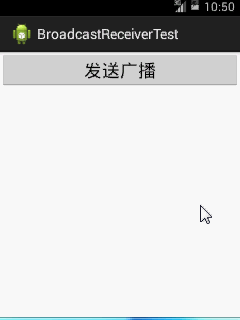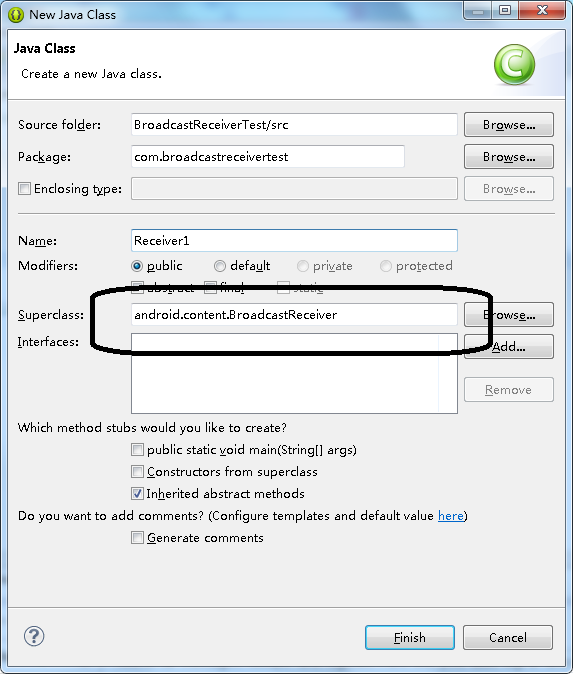- 1面试经验|字节后端实习 一二三面(凉经)_凉经是什么意思面试
- 2第十一届蓝桥杯赛后总结 —— 两年征战蓝桥,惜败来年再战。_蓝桥杯能提前离场吗
- 3会写代码的AI开源了!C语言写得比Codex还要好,掌握12种编程语言丨CMU
- 4生活哲理小故事系列(转贴)_生活故事博客推荐
- 5区块链交易所技术开发架构解析 交易所开发团队
- 6Pycharm2023.2左右版本出现项目无法自动关闭的问题(真解决方法!)_pycharm关闭后一直显示正在关闭项目
- 7报错解决:No module named ‘pytorch_lightning‘ 安装pytorch_lightning_no module named 'pytorch_lightning
- 8「NodeJs」nodejs 定时任务
- 9HG532命令执行漏洞复现(CVE-2017-17215)_安装attifyos v3.0虚拟机
- 10【华为网络-配置-001】-路由器接口、交换机接口 IP 地址配置_华为交换机端口配置ip
【Android】Broadcast Receiver的基本使用,推一条广播给多个Receiver_sendbroadcast 同时给两个广播发信息
赞
踩
Android所谓的四大组件:Activity,这个大家只要会写Android程序都知道是一个界面的意思,Service,这个专门用来用来后台推送,就是一条没有界面的线程,具体在《【Android】揭秘如何利用Service与线程制造安卓后台通知栏推送 》(点击打开链接)已经介绍过了,Content Provider这个也很常用,可以快速地直接拿内存卡的数据、Sqlite数据库中的数据,具体在《【Android】利用安卓的数据接口、多媒体处理编写内存卡Mp3播放器app》(点击打开链接)与《【Android】Sqlite数据库增删改查》(点击打开链接)中都已经讲过了。唯独只有广播器Broadcast Receiver少用,数安卓四大组件的时候经常忘记,其实这东西,说白的,就是专门在一堆Java文件中传递数据的。
如下图的一个安卓工程,如果你需要在MainActivity中发送一条信息,同时给Receiver1、2、3三个Java文件收到,然后这3个Java文件同时收到广播之后该干嘛干嘛,那么Broadcast Receiver就派上用场了。其中Receiver1、2、3三个Java文件没有界面,类似于Service,专门用来处理一些后台数据。
比如如下的一个例子。在MainActivity.java点击“发送广播”的按钮,Receiver1、2、3得到广播信息之后,则会Toast信息,基本上,Receiver1、2、3是同时Toast信息的。
制作过程如下,首先是一些比较杂七杂八的部分,在res\values\strings.xml中设置按钮的字体:
- <?xml version="1.0" encoding="utf-8"?>
- <resources>
-
- <string name="app_name">BroadcastReceiverTest</string>
- <string name="action_settings">Settings</string>
- <string name="button1">发送广播</string>
-
- </resources>
在res\layout\activity_main.xml中给MainActivity.java布置一个带ID按钮:
- <LinearLayout xmlns:android="http://schemas.android.com/apk/res/android"
- android:layout_width="match_parent"
- android:layout_height="match_parent"
- android:orientation="vertical" >
-
- <Button
- android:id="@+id/Button1"
- android:layout_width="match_parent"
- android:layout_height="wrap_content"
- android:text="@string/button1"
- android:textSize="24sp" />
-
- </LinearLayout>
MainActivity.java获取这个按钮之后,设置其点击事件是发送广播,广播的标识是android.intent.action.MY_BROADCAST,内容是“呵呵”,相当于现实世界的频段。不是这个频段的Java文件中Broadcast Receiver,是无法接受到“呵呵”信息的。如同《【Android】多个Activity之间利用bundle传递数值》( 点击打开链接)一样,这里的信息载体还是intent。sendBroadcast是发送广播,安卓中特定的方法可以直接使用,将这个intent发送给标识是android.intent.action.MY_BROADCAST的Receiver。
- package com.broadcastreceivertest;
-
- import android.os.Bundle;
- import android.view.View;
- import android.view.View.OnClickListener;
- import android.widget.Button;
- import android.app.Activity;
- import android.content.Intent;
-
- public class MainActivity extends Activity {
- private Button button1;
-
- @Override
- protected void onCreate(Bundle savedInstanceState) {
- super.onCreate(savedInstanceState);
- setContentView(R.layout.activity_main);
- button1 = (Button) findViewById(R.id.Button1);
- button1.setOnClickListener(new OnClickListener() {
- @Override
- public void onClick(View v) {
- Intent intent = new Intent("android.intent.action.MY_BROADCAST");
- intent.putExtra("msg", "呵呵!");
- sendBroadcast(intent);// 直接就是一个特定方法可以直接使用~
- }
- });
- }
- }

接下来,在AndroidManifest.xml注册三个标识是android.intent.action.MY_BROADCAST的Receiver,指明其接受的Java文件,也就是所谓的类,还有广播标识。如同注册Activity一样。
- <?xml version="1.0" encoding="utf-8"?>
- <manifest xmlns:android="http://schemas.android.com/apk/res/android"
- package="com.broadcastreceivertest"
- android:versionCode="1"
- android:versionName="1.0" >
-
- <uses-sdk
- android:minSdkVersion="8"
- android:targetSdkVersion="18" />
-
- <application
- android:allowBackup="true"
- android:icon="@drawable/ic_launcher"
- android:label="@string/app_name"
- android:theme="@style/AppTheme" >
- <activity
- android:name="com.broadcastreceivertest.MainActivity"
- android:label="@string/app_name" >
- <intent-filter>
- <action android:name="android.intent.action.MAIN" />
-
- <category android:name="android.intent.category.LAUNCHER" />
- </intent-filter>
- </activity>
-
- <!-- 注册3个广播接收器 -->
- <!-- 接收器1 -->
- <receiver android:name=".Receiver1" > <!-- 接收的Java文件 -->
- <intent-filter>
- <action android:name="android.intent.action.MY_BROADCAST" /> <!-- 广播器的标识(频段) -->
-
- <category android:name="android.intent.category.DEFAULT" />
- </intent-filter>
- </receiver>
- <!-- 接收器2 -->
- <receiver android:name=".Receiver2" >
- <intent-filter>
- <action android:name="android.intent.action.MY_BROADCAST" />
-
- <category android:name="android.intent.category.DEFAULT" />
- </intent-filter>
- </receiver>
- <!-- 接收器3 -->
- <receiver android:name=".Receiver3" >
- <intent-filter>
- <action android:name="android.intent.action.MY_BROADCAST" />
-
- <category android:name="android.intent.category.DEFAULT" />
- </intent-filter>
- </receiver>
- </application>
-
- </manifest>

之后,在主包com.broadcastreceivertest如下图新建3个Java文件Receiver1、2、3,皆继承android.content.BroadcastReceiver
其代码如下:
Receiver1.java
- package com.broadcastreceivertest;
-
- import android.content.BroadcastReceiver;
- import android.content.Context;
- import android.content.Intent;
- import android.widget.Toast;
-
- public class Receiver1 extends BroadcastReceiver {
-
- @Override
- public void onReceive(Context context, Intent intent) {
- String msg = intent.getStringExtra("msg");
- Toast.makeText(context, "Receiver1得到信息:"+msg, Toast.LENGTH_SHORT).show();
- }
-
- }

Receiver2.java
- package com.broadcastreceivertest;
-
- import android.content.BroadcastReceiver;
- import android.content.Context;
- import android.content.Intent;
- import android.widget.Toast;
-
- public class Receiver2 extends BroadcastReceiver {
-
- @Override
- public void onReceive(Context context, Intent intent) {
- String msg = intent.getStringExtra("msg");
- Toast.makeText(context, "Receiver2得到信息:"+msg, Toast.LENGTH_SHORT).show();
- }
-
- }

Receiver3.java
- package com.broadcastreceivertest;
-
- import android.content.BroadcastReceiver;
- import android.content.Context;
- import android.content.Intent;
- import android.widget.Toast;
-
- public class Receiver3 extends BroadcastReceiver {
-
- @Override
- public void onReceive(Context context, Intent intent) {
- String msg = intent.getStringExtra("msg");
- Toast.makeText(context, "Receiver3得到信息:"+msg, Toast.LENGTH_SHORT).show();
- }
-
- }

可以看到这3个Java文件的结构都是类似的,重写onReceive方法中的context参数就是该Java文件在安卓系统的上下文,Toast等需求上下文来实现的东东,就用直接用此上下文即可,之后的intent,就是广播信息传递过来的intent,用intent.getStringExtra就能解释其中的key-value对。
在结果可以看出以上利用了Broadcast Receiver完成MainActivity.java对Receiver1、2、3.java的操控。





